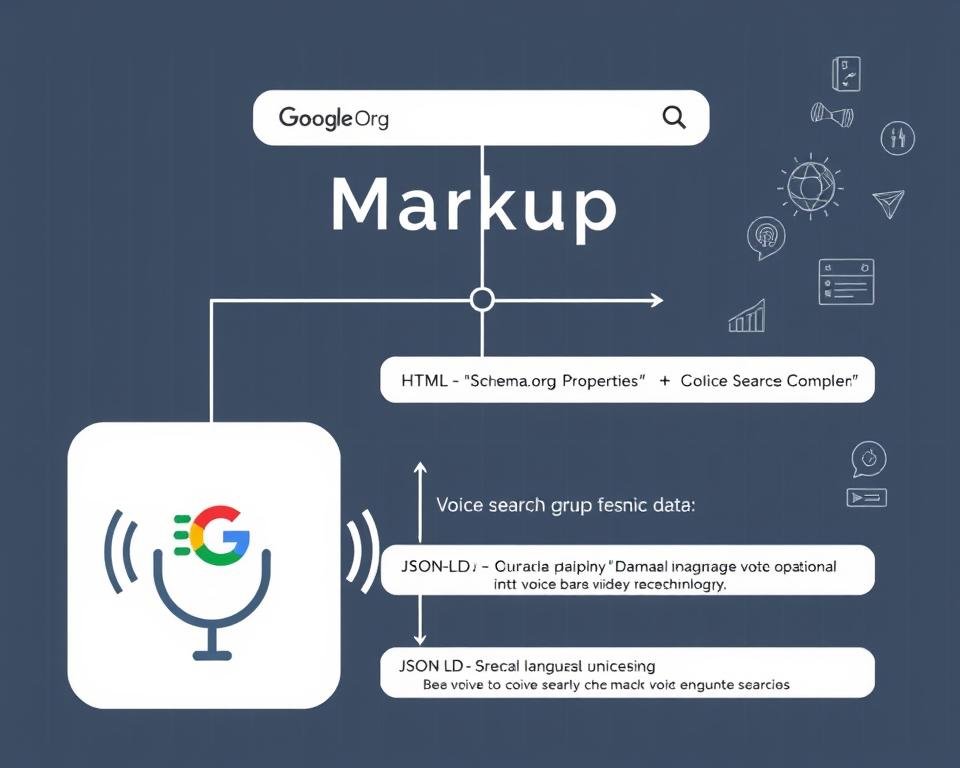I’ve seen how voice assistants like Siri and Google Assistant changed tech use. Now, making your site work for voice conversational queries is key.
For conversational queries, SEO needs a new way. It’s about how we talk and the voice commands we use. By making your site voice-friendly, you can get more visitors and sales.
Key Takeaways
- Understand the differences between voice and text-based searches.
- Optimize your content for natural, conversational language.
- Use long-tail keywords to target specific voice queries.
- Improve your website’s local SEO to capture voice searches.
- Ensure your website is mobile-friendly and has fast loading speeds.
Understanding Voice Search SEO
Voice search is becoming more popular. It’s important to know how to make your content work for it. Voice assistants like Siri and Google Assistant are changing how we search.
What is Voice Search SEO?
Voice search SEO means making your content answer questions spoken by users. It’s different from regular SEO because voice searches are longer and more like talking.
To rank better in voice search, create content that’s natural and answers questions well.
The Rise of Voice Search
More people are using voice search to find things and make purchases. It’s becoming a big part of our lives.
Key statistics on voice search include:
- Over 50% of households are expected to own a smart speaker by 2024.
- Voice search is used by over 25% of the global population.
- Voice assistants are becoming increasingly accurate, with some achieving accuracy rates of over 95%.
Key Differences Between Text and Voice Search
Voice searches are longer and more like talking. They often ask questions or give commands.
To show the differences, here’s a table:
| Characteristics | Text Search | Voice Search |
|---|---|---|
| Query Length | Typically short (2-3 words) | Often longer (5-7 words) |
| Query Structure | Usually keywords or phrases | Often questions or natural language |
| User Intent | Varied, but often informational or navigational | Typically informational or transactional |
Knowing these differences helps you make your site better for voice search. This can bring more visitors to your site.
Importance of Conversational Queries
Understanding conversational queries is key to voice search SEO success. These queries show how users talk to search engines.
How Users Approach Voice Search
Users talk differently to voice search than text search. They often use full sentences or questions. This means we need a new way to do voice search keyword research.
For example, someone might type “best Italian restaurants” online. But with voice search, they might say “What are the best Italian restaurants near me?” This shows we need to write in a more conversational style.

The Role of Natural Language Processing
Natural Language Processing (NLP) is key for understanding conversational queries. NLP lets computers get what we mean when we speak. This makes voice search results more accurate.
With NLP, search engines get the context and what we really want. This means our content needs to be both conversational and relevant to what we’re looking for.
To do well in voice search, we must create content that sounds like real speech. It should also give clear answers to questions we often ask.
Techniques for Optimizing Content
To make your content better for voice search, you need a smart plan. This plan should focus on how people talk. You must use special techniques to make your site easier to find.
Using Long-Tail Keywords
One good way is to use long-tail keywords. These are longer and more like how we speak. For example, instead of “best Italian restaurants,” try “What are the best Italian restaurants in New York City?” This makes your content more relevant to voice searches.
Long-tail keywords help your site show up more in voice searches. By adding these keywords naturally, you can make your site more visible.
Structuring Content for Voice Queries
Another key technique is to make your content answer voice search questions. People using voice search often ask questions. So, make sure your content gives clear, quick answers.
- Use a question-and-answer format to address common queries.
- Organize your content with headings and subheadings to improve readability.
- Ensure that your content provides direct, concise answers.
Answering Common Questions
It’s important to answer common questions in your field. This makes your site more useful and visible. By giving answers that meet your audience’s needs, you improve their experience.
| Question Type | Example | Content Strategy |
|---|---|---|
| Definition | What is voice search SEO? | Provide a clear, concise definition. |
| Solution | How do I optimize my website for voice search? | Offer step-by-step guidance. |
| Comparison | How does voice search differ from text search? | Highlight key differences and similarities. |

By using these methods, you can make your site better for voice search. Focus on long-tail keywords, structure your content for voice, and answer common questions. These are key steps to boost your voice search SEO.
Local SEO and Voice Search
The rise of voice search has made local SEO very important. Businesses need to make their online presence better for location-based searches. Knowing how to use local SEO strategies is key to showing up in voice search results.
The Significance of Localized Content
Localized content is key for businesses in specific areas. By making content for local people, businesses can show up more in local searches. This means using local keywords, talking about local events, and sharing info on local services.
Key benefits of localized content include:
- Increased relevance to local search queries
- Improved visibility in local search results
- Enhanced engagement with local audiences

Optimizing Google My Business for Voice
Google My Business (GMB) is a big deal for local SEO and voice search. Making your GMB listing better can help you show up in local voice searches. It’s important to keep your business info right, up-to-date, and full.
Steps to optimize GMB for voice search include:
- Claiming and verifying your GMB listing
- Providing detailed business information, including hours, address, and services
- Encouraging customers to leave reviews on your GMB listing
Voice Search and Featured Snippets
Voice search is getting more popular. It’s key to know about featured snippets for a good voice search plan. Featured snippets give quick answers to questions.

What are Featured Snippets?
Featured snippets are short summaries at the top of search pages. They give direct answers to questions. They’re vital for voice search, as they’re often used by Siri, Google Assistant, and Alexa.
How to Capture Featured Snippets
To get featured snippets, you need a smart content plan. Here are some tips:
- Use simple and clear language.
- Use headings and subheadings to organize your content.
- Answer common questions directly.
- Make sure your content has the right keywords.
By using these tips, you can get your site seen more in voice search. This helps your voice search plan a lot.
Mobile Optimization for Voice Search
With voice search on the rise, having a mobile-friendly website is key. Most voice searches happen on mobiles. So, making sure your site works well on these devices is vital for voice search success.
The Link Between Mobile and Voice Search
Many people use their mobiles for voice searches. This makes mobile optimization a must for voice search SEO. A site that works well on mobiles not only helps users but also boosts your site’s search engine ranking.
Key aspects of mobile optimization include:
- Responsive design that adapts to various screen sizes
- Fast page loading speeds to reduce bounce rates
- Easy navigation and clear content layout

Tips for Mobile-Friendly Content
To make your content mobile-friendly, aim for short and simple info. Use clear headings, short paragraphs, and bullet points to make it easy to read.
Best practices for mobile-friendly content include:
- Using a conversational tone that mirrors voice search queries
- Incorporating long-tail keywords relevant to voice search keyword research
- Ensuring content is easily accessible and readable on smaller screens, which is vital for voice search content creation
By following these tips, you can make your site better for voice search. And you’ll also give your mobile visitors a great experience.
User Experience and Voice Search
User experience is key in voice search. It affects how fast and relevant search results are. A well-optimized site ranks better in voice search and improves user experience.
Two important factors are site speed and navigation. Let’s explore why they matter for voice search.
Enhancing Site Speed
Site speed is vital for voice search. Users want quick and accurate results. A slow site hurts user experience and search rankings.
To speed up your site, try these:
- Optimize images: Compressing images can make pages load faster.
- Minify CSS and JavaScript files: Smaller files mean faster loading.
- Leverage browser caching: Store often-used resources locally to avoid repeat downloads.
- Use a content delivery network (CDN): Spread content across servers to cut down on latency.

Ensuring Easy Navigation
Navigation is also critical. It lets users find what they need fast. Here are some tips to improve navigation:
- Simplify menu structures: Don’t overload menus with too many choices.
- Use clear and concise labels: Make sure labels match what they represent.
- Implement a search function: A search bar helps users find specific content.
- Optimize for mobile: Make sure your site works well on mobile, as many searches happen on phones.
By improving site speed and navigation, businesses can better serve voice search users. This leads to better rankings and more conversions.
Monitoring and Analyzing Voice Search Performance
To see how well your voice search SEO is doing, you need to check it often. You must know the important numbers that show if your plans are working. Also, you should use the best tools to look at your results.
Key Metrics to Track
For voice search SEO, there are key numbers you should watch. These include:
- Voice search rankings: Keep an eye on how your content ranks for voice search. This shows how visible you are.
- Conversion rates: Watch how many people take action after finding your site through voice search. This shows if your SEO is working.
- Average position: Look at your average spot in search results for voice queries.
By watching these numbers, you can learn about your voice search performance. You can also find what needs to get better.
Tools for Voice Search SEO Analysis
To really understand your voice search performance, you need the right tools. Some top tools are:
- Google Search Console: Gives you insights into your website’s search traffic, including voice search queries.
- Google Analytics: Helps you track voice search traffic and conversion rates.
- SEMrush: Offers detailed SEO audits and tracks keyword rankings, including voice search ones.
With these tools, you can learn more about your voice search performance. You can make smart choices to improve your SEO plans.
Future Trends in Voice Search SEO
Voice search SEO is about to change a lot thanks to AI and machine learning. These technologies will make voice search better and change how businesses use it.
AI and machine learning are making voice search smarter. It’s now easier to use and understand. It can guess what you want and give you the right answers.
Impact of AI and Machine Learning
AI and machine learning are making voice search more accurate and useful. They help with understanding natural language and learning from users.
- Enhanced natural language understanding
- Personalization based on user behavior
- Improved accuracy in search results
Businesses need to update their voice search strategy. They should use more conversational and long-tail keywords. This is how people talk naturally.
Predictions for Voice Search Growth
Voice search is growing fast, thanks to smart speakers and voice-enabled devices. It’s key for businesses to improve voice search rankings to stay competitive.
| Year | Voice Search Growth Prediction | SEO Impact |
|---|---|---|
| 2024 | 25% increase in voice search users | Higher emphasis on conversational keywords |
| 2025 | 40% of households to own smart speakers | Increased focus on local SEO for voice |
| 2026 | Voice search to become a primary search method | Need for more sophisticated voice search optimization techniques |

By keeping up with these trends, you can lead the way. This will help you be more visible in voice search results.
Best Practices for Continuous Optimization
To stay ahead in voice search, you must keep optimizing your content. Voice search tech changes fast. So, it’s key to keep up with new trends and best practices.
Staying Current with Voice Search Trends
I do deep voice search keyword research. This helps me find the right conversational queries. I look at how users behave and patterns in voice search data to shape my content.
Regularly Refreshing Content
Keeping my content fresh is essential. I create new voice search content that meets my audience’s needs. This keeps my site competitive.
By following these steps, my website stays visible and competitive in the voice search world.
